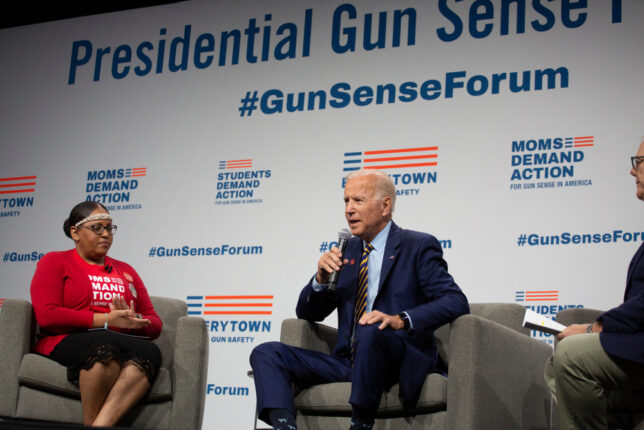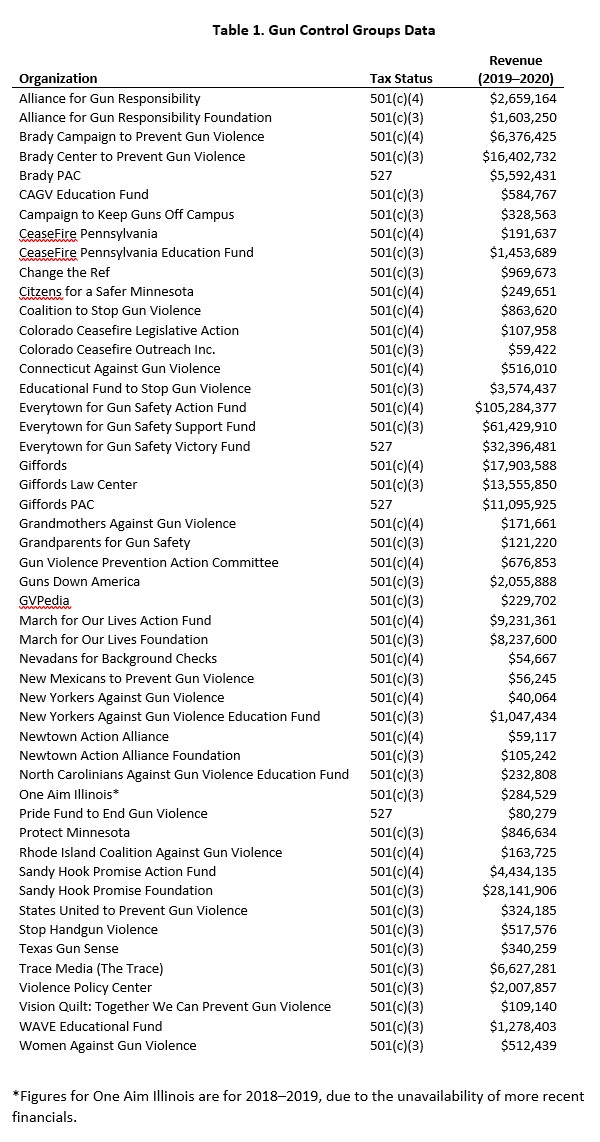Organization Trends
The Landscape of Gun Control Advocacy
 Presidential candidate Joe Biden addresses rally on gun safety in Des Moines, Iowa, on August 8, 2019. Credit: CJ Hanevy. License: Shutterstock.
Presidential candidate Joe Biden addresses rally on gun safety in Des Moines, Iowa, on August 8, 2019. Credit: CJ Hanevy. License: Shutterstock.

Gun Control Advocacy (full series)
Landscape | Funders | Policies
Dozens of gun control advocacy groups are active in the United States, and detailed financial information is available on at least 50. This includes groups organized as 501(c)(3) charities, 501(c)(4) social welfare organizations, and 527 political action committees. A financial analysis of these 50 groups reveals that during the two-year period covering 2019–2020, about $153 million flowed into 501(c)(3)s, about $149 million flowed into 501(c)(4)s, and about $49.1 million flowed into 527s.
While these numbers give a rough indication of how much “gun control money” is out there, they cannot simply be added together to obtain a precise grand total because affiliated groups can and do contribute to one another in any given year, which raises the risk of double counting.
Still, these figures do suggest two interesting additional data points. First, just five groups dominate the nonprofit gun control advocacy landscape from a financial standpoint. Second, 501(c)(3) charities are key funding conduits for activism, even on a thoroughly political issue like gun control.
Methodology and Other Considerations
For the purposes of this research, an organization was considered a gun control advocacy group if it appeared primarily focused on the ownership and/or use of firearms by American civilians, and if it promoted increased restrictions on such ownership or use. Although admittedly a bit subjective, dozens of distinct nonprofits seem to fit fairly within these criteria. These were categorized by their tax-exempt status, and their reported revenues in both 2019 and 2020 were combined. Figures for 501(c)(3) and 501(c)(4) nonprofits were obtained from Form 990s covering the fiscal years that ended in 2019 and 2020, while figures for 527 groups were obtained from OpenSecrets and covered the entire 2020 election cycle.
During this period, gun control groups organized as 501(c)(3) charities reported $153,038,641 in combined revenue. Those organized as 501(c)(4) social welfare organizations reported $148,984,013. And those organized as 527 political action committees reported $49,165,116. While these numbers cannot simply be added together due to the risk of double-counting funds that one gun control group may have contributed to another, a few other notes and observations suggest that these figures are otherwise probably on the conservative side.
First, groups for which precise financial information was unavailable were excluded. This includes fiscally sponsored projects like Fund for a Safer Future (a project of the New Venture Fund, managed by Arabella Advisors), as well as groups housed at universities such as the Johns Hopkins Center for Gun Violence Solutions. Also excluded for this reason were small nonprofits that filed a Form 990-N by virtue of having annual gross receipts of $50,000 or less.
Second, multi-issue groups for which gun control accounts for only a portion of their advocacy were excluded. A January 2023 letter from a coalition called The Time is Now, urging President Joe Biden to be more aggressive on the issue, was signed by more than 100 activist groups—including some that the public would rarely if ever associate specifically with gun control. They included the American Federation of Teachers, the Rainbow PUSH Coalition, the Union for Reform Judaism, and Equality California. Major liberal public policy groups like the Center for American Progress, the Brennan Center for Justice, and the League of Women Voters also devote some portion of their work to gun control, among many other issues, but were likewise excluded.
Finally, some judgment calls simply could not be avoided. For example, gun control advocacy groups use data from the Gun Violence Archive to support their activism, but because the group itself does not promote gun control as policy, the Gun Violence Archive was excluded from the total. However, if a gun control advocacy group exists as part of a family of affiliated nonprofits—for example, a 501(c)(3) with an affiliated 501(c)(4)—all of those groups were included if their financials were available.
Accordingly, the Sandy Hook Promise Foundation was included despite its substantial work in other areas because the affiliated Sandy Hook Promise Action Fund promotes gun control. The two groups share overlapping leadership and complementary websites, direct prospective donors to one another under the same public brand, and promote gun control policies on shared social media. It simply feels more accurate to include groups like the Sandy Hook Promise Foundation than to exclude them, and it is worth noting that informed commentators such as The Chronicle of Philanthropy have done the same.
The Big Five
In addition to identifying America’s gun control advocacy groups and giving a rough idea of how much money they bring in, the biggest takeaways from this research are twofold. First, even though gun control is a decidedly political issue, 501(c)(3) charities play a central role in the associated fundraising. Second, five groups dominate the gun control activism landscape: Everytown, Giffords, Brady, Sandy Hook Promise, and March for Our Lives. Even excluding their affiliated PACs, they still accounted for over 83 percent of the total 501(c)(3) money and over 96 percent of the 501(c)(4) money raised by the groups analyzed.
Everytown is the largest by a substantial margin. Its constituent 501(c)(3) Everytown for Gun Safety Support Fund brought in $61,429,910 in 2019–2020, while the 501(c)(4) Everytown for Gun Safety Action Fund brought in $105,284,377. The affiliated Everytown for Gun Safety Victory Fund reported raising $32,396,481 during the 2020 cycle, but it is important to keep in mind that about half of that total came from the 501(c)(4) Everytown for Gun Safety Action Fund itself, according to Open Secrets.
Giffords is comprised of the eponymous 501(c)(4) and the 501(c)(3) Giffords Law Center to Prevent Gun Violence, which reported revenues of $17,903,588 and $13,555,850, respectively, in 2019–2020. The affiliated Giffords PAC raised $11,095,925 during the 2020 cycle.
Brady consists of the 501(c)(4) Brady Campaign to Prevent Gun Violence and the 501(c)(3) Brady Center to Prevent Gun Violence. The 501(c)(4) arm reported revenues of $6,376,425 in 2019–2020, while the 501(c)(3) arm reported $16,402,732. There is also the Brady PAC, which raised $5,592,431 during the 2020 cycle.
Sandy Hook Promise consists of the 501(c)(3) Sandy Hook Promise Foundation and the affiliated 501(c)(4) Sandy Hook Promise Action Fund. The 501(c)(3) foundation raised significantly more money than the 501(c)(4) action fund in 2019–2020, reporting revenues of $28,141,906 compared to only $4,434,135 for the 501(c)(4) action fund.
March for Our Lives is made up of the 501(c)(4) March for Our Lives Action Fund and the affiliated 501(c)(3) March for Our Lives Foundation. The action fund’s 2019-2020 revenues were $9,231,361, while the foundation’s were $8,237,600. However, the 501(c)(3) foundation reported making a $3,500,000 grant to the 501(c)(4) action fund in 2019 for “nonpartisan charitable and educational activities.”
Of the remaining groups, notable ones include The Trace, a 501(c)(3) with combined 2019–2020 revenues of $6,627,281, and the Violence Policy Center, another 501(c)(3), with revenues of $2,007,857 over that same period. The 501(c)(4) Alliance for Gun Responsibility brought in $2,659,164, and the affiliated 501(c)(3) Alliance for Gun Responsibility Foundation brought in $1,603,250. The 501(c)(3) Educational Fund to Stop Gun Violence also brought in $3,574,437 in 2019–2020, but it has since merged into the Johns Hopkins Center for Gun Violence Solutions, housed at the university’s Bloomberg School of Public Health.
The full list of gun control groups, their tax statuses, and their 2019–2020 revenue is available below.




